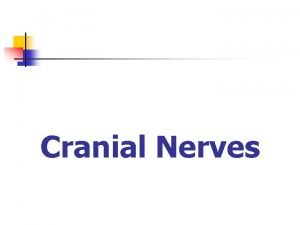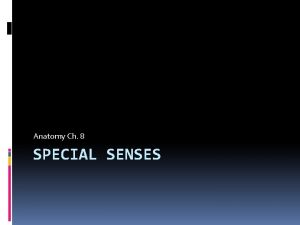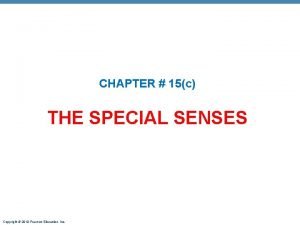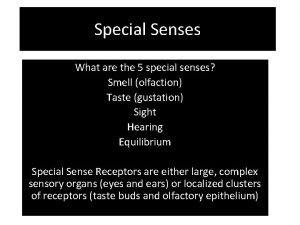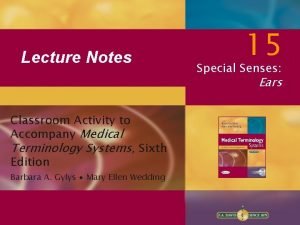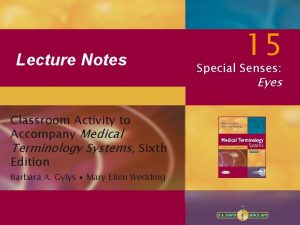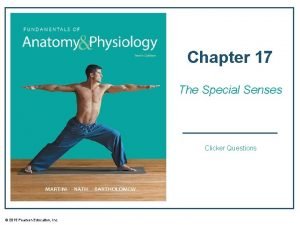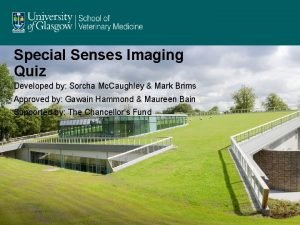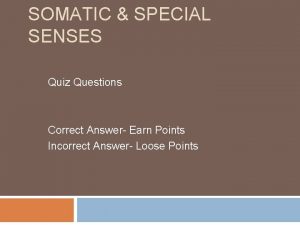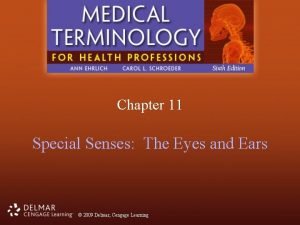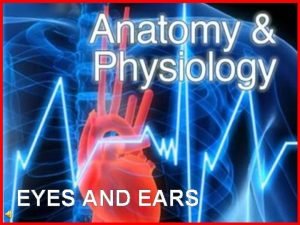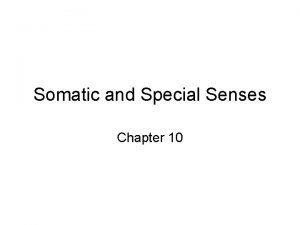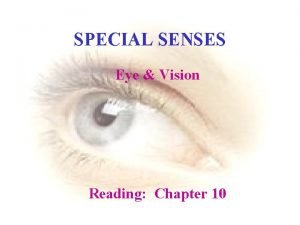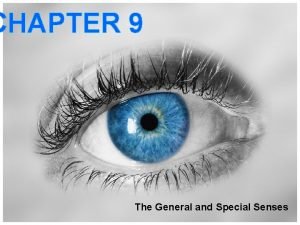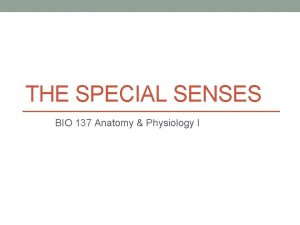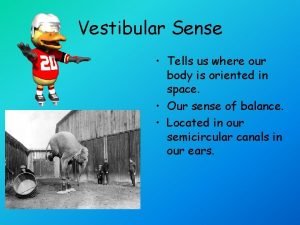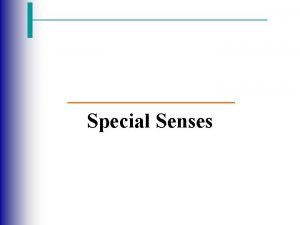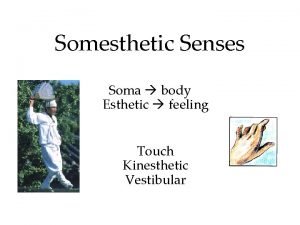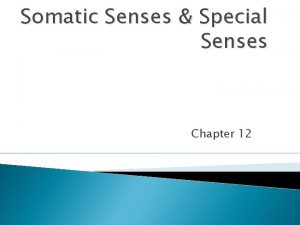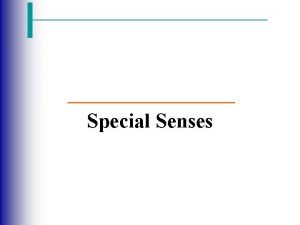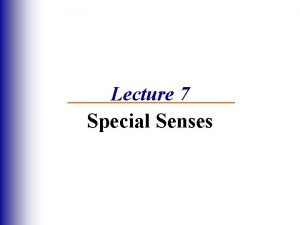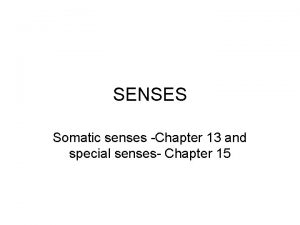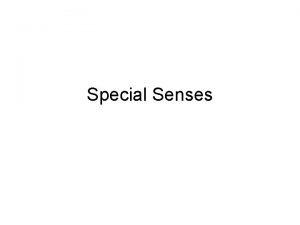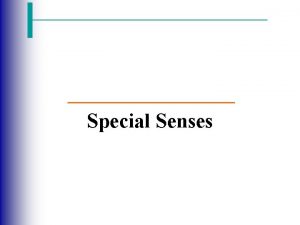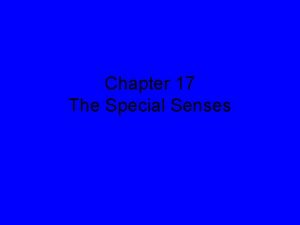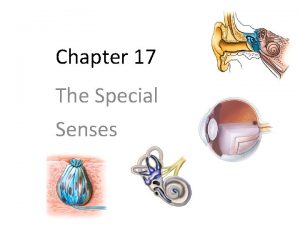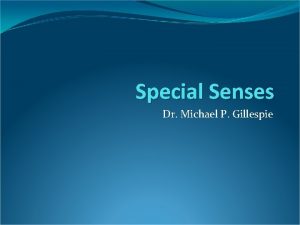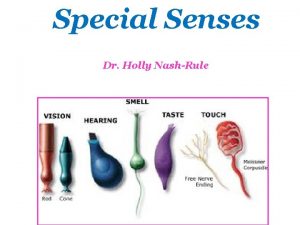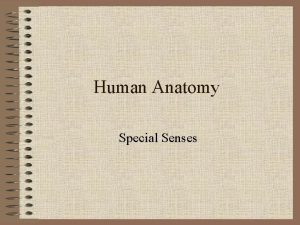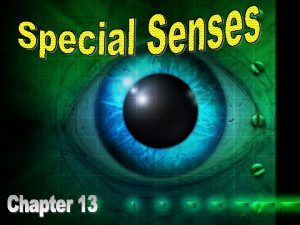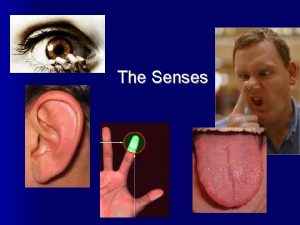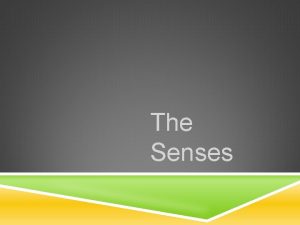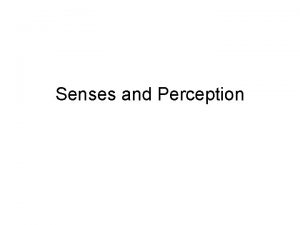THE SPECIAL SENSES 5 SPECIAL SENSES 1 2






































































- Slides: 70

THE SPECIAL SENSES

5 SPECIAL SENSES 1. 2. 3. 4. 5. Olfaction Gustation Hearing Equilibrium Vision

OLFACTORY ORGANS Located in nasal cavity on either side of nasal septum Figure 17– 1 a

WHAT ARE THE SENSORY ORGANS OF SMELL?

OLFACTORY ORGANS Made up of 2 layers: olfactory epithelium lamina propria

OLFACTORY EPITHELIUM Figure 17– 1 b

OLFACTORY EPITHELIUM Contains: olfactory receptors supporting cells basal (stem) cells

LAMINA PROPRIA Contains: areolar tissue blood vessels nerves olfactory glands

OLFACTORY GLANDS Secretions coat surfaces of olfactory organs

OLFACTORY RECEPTORS Highly modified neurons Figure 17– 1 b

OLFACTORY RECEPTION Involves detecting dissolved chemicals as they interact with odorant-binding proteins

WHAT ARE THE SENSORY ORGANS OF TASTE?

TASTE (GUSTATORY) RECEPTORS Clustered in taste buds

TASTE BUDS Associated with epithelial projections (lingual papillae) on dorsal surface of tongue

TASTE BUDS Figure 17– 2

EACH TASTE BUD Contains: basal (stem) cells gustatory cells: Extend taste hairs through taste pore Survive only 10 days before replacement

PRIMARY TASTE SENSATIONS Sweet Salty Sour Bitter

WHAT ARE THE SENSORY ORGANS OF HEARING AND EQUILIBRIUM?

THE EAR Figure 17– 20

THE EAR 1. 2. 3. External ear Middle ear Inner ear

WHAT ARE THE STRUCTURES OF THE EXTERNAL EAR, AND HOW DO THEY FUNCTION?

EXTERNAL EAR Auricle Surrounds entrance to external acoustic canal Protects opening of canal Provides directional sensitivity External acoustic canal Canal that runs from auricle to tympanic membrane Tympanic membrane (Eardrum) Is a thin, semitransparent sheet Separates external ear from middle ear

EXTERNAL EAR Figure 17– 20

CERUMINOUS GLANDS Integumentary glands along external acoustic canal Secrete waxy material (cerumen): keeps foreign objects out of tympanic membrane slows growth of microorganisms in external acoustic canal

WHAT ARE THE STRUCTURES OF THE MIDDLE EAR, AND HOW DO THEY FUNCTION?

3 AUDITORY OSSICLES 1. 2. 3. Malleus (hammer) Incus (anvil) Stapes (stirrup)

AUDITORY TUBE (EUSTACHIAN TUBE) Permits equalization of pressures on either side of tympanic membrane

VIBRATION OF TYMPANIC MEMBRANE Converts arriving sound waves into mechanical movements Auditory ossicles conduct vibrations to inner ear

WHAT ARE THE PARTS OF THE INNER EAR, AND WHAT ARE THEIR ROLES IN EQUILIBRIUM AND HEARING?

INNER EAR Figure 17– 20

INNER EAR Contains fluid Subdivided into: vestibule semicircular cochlea canals

INNER EAR

PARTS TO INNER EAR Vestibular Complex Combination of vestibule and semicircular canals Vestibule Receptors provide sensations of gravity and linear acceleration Semicircular Canals Contain semicircular ducts Receptors stimulated by rotation of head Cochlea Contains cochlear duct Receptors provide sense of hearing

PARTS TO INNER EAR

EQUILIBRIUM Sensations provided by receptors of vestibular complex

SOUND Consists of waves of pressure through air or water

WAVELENGTH Distance between 2 adjacent wave troughs Frequency Number of waves that pass fixed reference point at given time Physicists use term cycles instead of waves Hertz (Hz) Number of cycles per second (cps)

PITCH Our sensory response to frequency Increased frequency results in a higher pitch Decreased frequency results in a lower pitch

AMPLITUDE Intensity of sound wave Sound energy is reported in decibels

THE POWER OF SOUNDS Table 17– 1

HOW DO WE HEAR? 1. 2. 3. 4. 5. Sound waves enter external acoustic canal Soundwaves vibrate the tympanic membrane Vibrations are transferred to and through the auditory ossicles Vibrations are transferred to fluid in cochlea Nerve endings pick up vibrations and send signal to brain

HOW DO WE HEAR?

AGING EFFECTS Tympanic membrane gets less flexible Articulations between ossicles stiffen

WHAT ARE THE ACCESSORY STRUCTURES OF THE EYE, AND WHAT ARE THEIR FUNCTIONS?

ACCESSORY STRUCTURES OF THE EYE 1. 2. 3. Eyelids Superficial epithelium of eye Structures associated with production, secretion, and removal of tears

EYELIDS (PALPEBRAE) Continuation of skin Blinking keeps surface of eye lubricated, free of dust, and debris

EYELASHES Robust hairs that prevent foreign matter from reaching surface of eye

TARSAL GLANDS Associated with eyelashes Secrete lipid–rich product that helps keep eyelids from sticking together Contribute to gritty deposits that appear after good night’s sleep

CONJUNCTIVA Epithelium covering inner surfaces of eyelids and outer surface of eye Conjunctivitis Results from damage to conjunctival surface Figure 17– 3 b

CORNEA Transparent part of outer fibrous layer of eye

LACRIMAL GLAND (TEAR GLAND) Secretions contain lysozyme, an antibacterial enzyme Lubricates, cleanses, disinfects eye

WHAT ARE THE INTERNAL STRUCTURES OF THE EYE, AND WHAT ARE THEIR FUNCTIONS?

ORBITAL FAT Cushions and insulates eye Figure 17– 4 c

EYEBALL Is hollow Is divided into 2 cavities: large posterior cavity smaller anterior cavity

OUTER SURFACE OF EYE 1. 2. Sclera (white of eye) Cornea

MIDDLE LAYER OF EYE Includes: iris ciliary body Iris Contains muscle fibers Changes diameter of pupil Ciliary body Assist in changing shape of lens for focusing images

MIDDLE LAYER OF EYE

LENS Lies posterior to cornea Forms anterior boundary of posterior cavity

INNER LAYER OF EYE (RETINA) 1. 2. Outer pigmented part Inner neural part: contains visual receptors and associated neurons

RETINA Rods and cones are types of photoreceptors Figure 17– 6

RODS Do not discriminate light colors Highly sensitive to light intensity

CONES Provide color vision Densely clustered in fovea

VISUAL AXIS Imaginary line from center of object, through center of lens, to fovea Figure 17– 4 c

COLOR BLINDNESS Inability to detect certain colors Figure 17– 17

OPTIC DISC Circular region just medial to fovea Origin of optic nerve NO RODS OR CONES IN THIS REGION Creates a blind spot Figure 17– 6 b, c

BLIND SPOT Figure 17– 7

CATARACT Condition in which lens has lost its transparency

ASTIGMATISM Condition where light passing through cornea and lens is not refracted properly Visual image is distorted

VISUAL PATHWAY Figure 17– 19

DEPTH PERCEPTION By comparing relative positions of objects between left–eye and right–eye images Figure 17– 19
 What is the difference between somatic and special senses
What is the difference between somatic and special senses Special vs general senses
Special vs general senses Cranial nerves special senses
Cranial nerves special senses The general senses
The general senses Eye anatomy
Eye anatomy Chapter 15 special senses
Chapter 15 special senses Five basic taste sensations
Five basic taste sensations Building vocabulary activity: the special senses
Building vocabulary activity: the special senses Building vocabulary activity: the special senses
Building vocabulary activity: the special senses Chapter 17 special senses answer key
Chapter 17 special senses answer key Somatic and special senses
Somatic and special senses Special senses quiz
Special senses quiz Chapter 15 special senses
Chapter 15 special senses The cones of the retina are coursera quiz answers
The cones of the retina are coursera quiz answers Special senses anatomy
Special senses anatomy Chapter 11 labeling exercises
Chapter 11 labeling exercises Special senses the eyes and ears
Special senses the eyes and ears Extraocular muscles
Extraocular muscles Chapter 10 somatic and special senses
Chapter 10 somatic and special senses Emmentropia
Emmentropia Anatomy and physiology chapter 8 special senses
Anatomy and physiology chapter 8 special senses The general and special senses chapter 9
The general and special senses chapter 9 Special senses physiology
Special senses physiology Conclusion of special senses
Conclusion of special senses Số nguyên là gì
Số nguyên là gì Fecboak
Fecboak Các châu lục và đại dương trên thế giới
Các châu lục và đại dương trên thế giới Glasgow thang điểm
Glasgow thang điểm Thế nào là hệ số cao nhất
Thế nào là hệ số cao nhất Sơ đồ cơ thể người
Sơ đồ cơ thể người Tư thế ngồi viết
Tư thế ngồi viết Bàn tay mà dây bẩn
Bàn tay mà dây bẩn đặc điểm cơ thể của người tối cổ
đặc điểm cơ thể của người tối cổ Cách giải mật thư tọa độ
Cách giải mật thư tọa độ Bổ thể
Bổ thể Tư thế ngồi viết
Tư thế ngồi viết ưu thế lai là gì
ưu thế lai là gì Thẻ vin
Thẻ vin Thơ thất ngôn tứ tuyệt đường luật
Thơ thất ngôn tứ tuyệt đường luật Các châu lục và đại dương trên thế giới
Các châu lục và đại dương trên thế giới Từ ngữ thể hiện lòng nhân hậu
Từ ngữ thể hiện lòng nhân hậu Diễn thế sinh thái là
Diễn thế sinh thái là Thế nào là giọng cùng tên
Thế nào là giọng cùng tên Vẽ hình chiếu vuông góc của vật thể sau
Vẽ hình chiếu vuông góc của vật thể sau Làm thế nào để 102-1=99
Làm thế nào để 102-1=99 Tỉ lệ cơ thể trẻ em
Tỉ lệ cơ thể trẻ em Bài hát chúa yêu trần thế alleluia
Bài hát chúa yêu trần thế alleluia Lời thề hippocrates
Lời thề hippocrates Hổ đẻ mỗi lứa mấy con
Hổ đẻ mỗi lứa mấy con đại từ thay thế
đại từ thay thế Quá trình desamine hóa có thể tạo ra
Quá trình desamine hóa có thể tạo ra Công thức tiính động năng
Công thức tiính động năng Thế nào là mạng điện lắp đặt kiểu nổi
Thế nào là mạng điện lắp đặt kiểu nổi Hình ảnh bộ gõ cơ thể búng tay
Hình ảnh bộ gõ cơ thể búng tay Dạng đột biến một nhiễm là
Dạng đột biến một nhiễm là Vẽ hình chiếu đứng bằng cạnh của vật thể
Vẽ hình chiếu đứng bằng cạnh của vật thể Phản ứng thế ankan
Phản ứng thế ankan Voi kéo gỗ như thế nào
Voi kéo gỗ như thế nào Các môn thể thao bắt đầu bằng tiếng đua
Các môn thể thao bắt đầu bằng tiếng đua Khi nào hổ con có thể sống độc lập
Khi nào hổ con có thể sống độc lập Thiếu nhi thế giới liên hoan
Thiếu nhi thế giới liên hoan điện thế nghỉ
điện thế nghỉ Một số thể thơ truyền thống
Một số thể thơ truyền thống Thế nào là sự mỏi cơ
Thế nào là sự mỏi cơ Trời xanh đây là của chúng ta thể thơ
Trời xanh đây là của chúng ta thể thơ Receptor cells for the vestibular sense are located in the
Receptor cells for the vestibular sense are located in the Taste anatomy
Taste anatomy Somesthetic senses
Somesthetic senses Lacrimal fluid
Lacrimal fluid Facts about taste
Facts about taste


